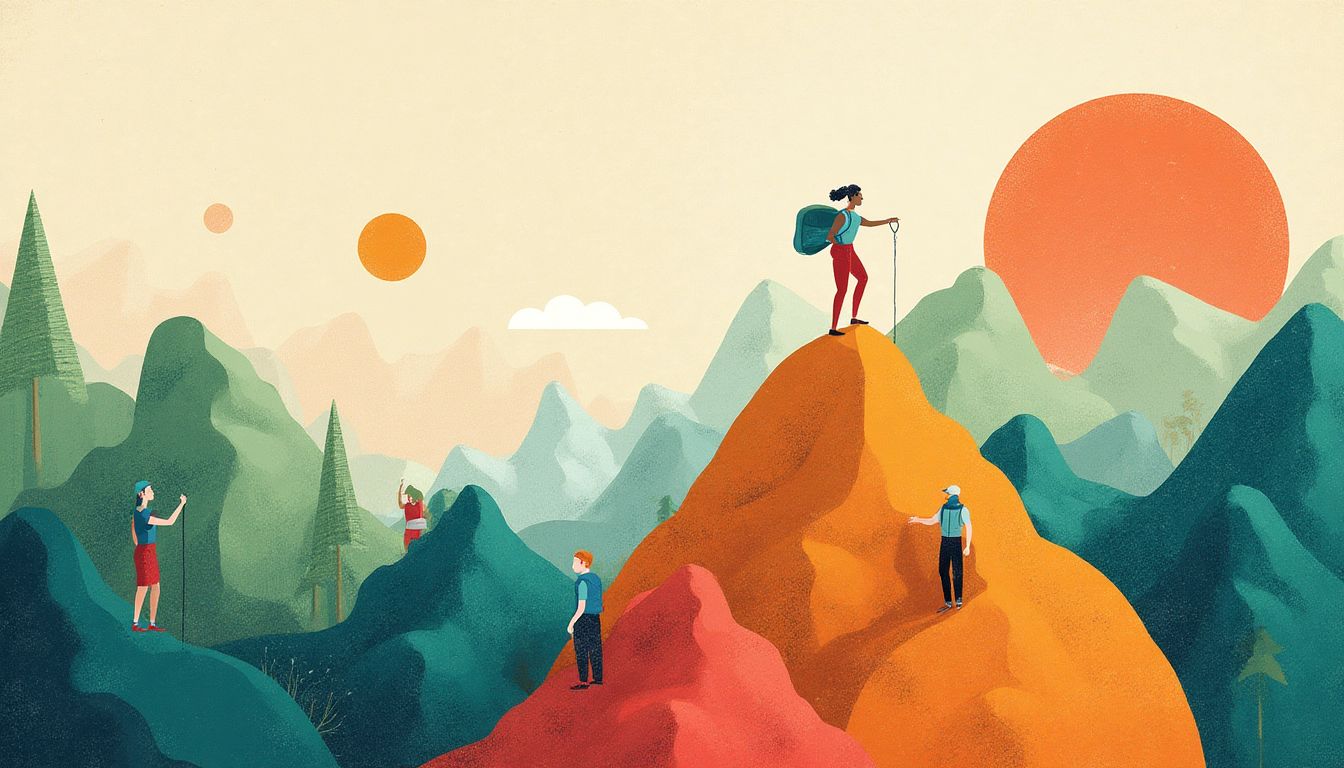Introduction: The Introduction Title
The greatest glory in living lies not in never falling, but in rising every time we fall. – Nelson Mandela. This profound statement encapsulates the essence of resilience—celebrating not the avoidance of challenges, but the ability to rise again. In today's fast-moving gear of convenience, is our ease of living threatening the development of this vital skill in future generations? As we automate, digitize, and optimize, are we inadvertently crafting a world ready to crumble at the first hint of adversity?
In a time when you can order groceries by simply clicking an app, or get a job done at the tap of a button, it's pertinent to ask whether this painless lifestyle is stripping away the grit that once defined human tenacity. With researchers like Angela Duckworth, known for her work on grit as a predictor of success, and essays from luminaries like Richard Sennett highlighting the perils of ease, the question becomes all the more pressing. Can a society devoid of struggle truly flourish?
Embracing Hardship: The Historical Context of Grit
Throughout the tapestry of human history, the thread of hardship has woven tapestries of strength and character. Just as medieval knights faced grueling trials to prove their valor, or pioneers braved untamed lands, grit has been at the heart of accomplishment. In ancient Rome, philosophers like Seneca and Marcus Aurelius embraced stoic philosophy, believing adversity shaped noble character. It's akin to the trials faced by characters in a J.K. Rowling saga, where each challenge shapes the hero's journey.
The Great Depression, often dubbed America's harshest teacher, is another example where struggle spurred resilience. Families knitted together with industrious thread, communities shared and built resilience from adversity. This wasn't just survival; it was a testament to human endurance. Imagine if such historical figures faced today's world, where 'struggle' means waiting an hour for device updates! Would they still develop the fortitude that history books celebrate?
In modern psychology, luminaries like Angela Duckworth argue that experiencing adversity builds a robust psyche. It's like building a muscle: without resistance, there's no growth. If we bypass life’s gym, could our collective character miss out on a crucial workout? Evidence suggests a correlation between challenges and emotional strength. Resilience isn’t just a nice-to-have; it’s essential for navigating life's labyrinth.
The Rise of Convenience: How Technology Changes Work
There's a digital revolution at play, and we are all invited! With technology becoming ubiquitous, it has reshaped the way work looks and feels. Remember the days when nine-to-five was the norm? Well, those days have gracefully exited the stage, making room for flexible work environments and roles that were mere figments of imagination a few decades ago.
Sub point of Point 2
The digital age ushers in "gig-economy"; out with the rigid and in with the spontaneous! Platforms like UpWork or Fiverr have transformed the job market into a flexible, choose-your-own-adventure novel, except with fewer dragons. Convenient? Absolutely. But it also means less manual labor and a dent in traditional work ethics. Cue existential contemplation...
Second Sub point of Point 2
Let's get real; convenience comes with its own set of unopened Pandora's boxes. Instant gratification is now as easy as ordering a pizza. Yet, the allure of comfort brings with it the risk of complacency among newer generations. Will kids of tomorrow be as tenacious as Grandma Joan who walked uphill both ways in the snow?
The Psychological Impact of a Comfort-Driven Society
Our comfort-driven culture leaves us perpetually wrapped in metaphorical bubble wrap, and that craft is being honed to a fine art. While armchairs grow softer and TV streams zoom faster, the mental effects of such a lifestyle are a culinary delight of their own-but often served cold.
Sub point of Point 3
Too much comfort can be like binging on ice cream; initially delightful, but with consequences. Research shows that high comfort can tie a Gordian knot around resilience levels. This slipperiness may result in heightened anxiety and a motivation deficit among youth.
Second Sub point of Point 3
In the pursuit of a balanced mental health regime, the significance of fostering resilience mustn't be overshadowed by the soft arms of excessive comfort-seeking. Aren't we all craving some vintage grit?
Contextualizing Resilience: Education’s Role
The role of education in shaping resilience is both immense and paradoxical. Today's educational systems are often caught in a conundrum, favoring a nurturing environment over one that challenges students. Education has become less about confronting adversity head-on and more about creating emotionally safe spaces. This shift might prevent students from experiencing failure and learning valuable lessons from it. It raises a critical question: are we doing students a disservice by not equipping them with the ability to overcome obstacles?
Consider the traditional schooling system, where excellence was achieved through rigorous effort and perseverance. It offered a trial by fire, instilling a determination that carried individuals through adulthood. But with the growing emphasis on emotional safety, we may have tipped the scales too far in one direction.
The implication here is multi-faceted:
- Students are shielded from the discomfort of failure, missing out on crucial character development.
- The educational focus shifts from knowledge acquisition and problem-solving to emotional well-being.
- There is a potential risk of creating a culture where students are ill-prepared for the workforce and life’s inevitable challenges.
The challenge now is to strike a balance between creating supportive environments and fostering resilience through challenge. Educators worldwide are engaged in debates, grappling with finding this equilibrium. Think of education as a well-tuned orchestra. It requires perfect harmony between nurturing environments and the inclusion of strategic challenges that enhance problem-solving skills, emotional strength, and resilience. The need is to implement resilience-building initiatives gently so students can confidently plunge into the test of life.
Cultural Narratives: Media Representations of Grit and Challenge
Media stands as a powerful architect of societal narratives, shaping how we perceive grit and challenge. Our encounters with protagonists fighting insurmountable odds on screen deeply move us, often leaving an indelible mark on our psyche. This raises questions about whose stories are celebrated, how they shape global perspectives on challenges, and how culture endorses the value of overcoming adversity.
Let's dive into the world of films and literature. Many iconic stories, ranging from "Rocky" to "Harry Potter," share a common thread of overcoming adversity. They cast a spotlight on the hero's journey, depicting trials that, although fictional, symbolize deeply relatable emotions and struggles. Such narratives, set in a universe of possibility, shape our expectations and understanding of growth and character formation.
Here's the interesting bit:
- Movies and books that present resilience arcs provide cultural touchstones that audiences hold onto as inspiring paradigms.
- The characters' victories often symbolize our deepest desire to triumph over chaos, to forge our path, and to emerge stronger.
- However, not all narratives are created equal. Some propagandize certain perspectives, overlooking diverse adversities faced by underrepresented communities.
Popular culture has the potential to shift perceptions, challenging conventional ideas of courage and endurance. It encourages society to reevaluate its notion of success, inviting a broader, more inclusive projection of resilience. Hollywood and media outlets can pioneer this change by choosing narratives that showcase a variety of experiences, thereby enriching global conception of grit. By celebrating diverse stories of challenge and triumph, we expand the collective understanding of the value imbued in overcoming life's hurdles.
AI Solutions: How Would AI Tackle This Issue?
As we glide deeper into the age of artificial intelligence, the prospect of utilizing machine learning and behavioral analytics to address the pitfalls of a post-work society seems not just possible but imperative. Imagine a world where AI acts not merely as a tool of convenience but as a guide to help foster resilience and grit among individuals. By leveraging cutting-edge technology, we can create personalized challenges that meet the unique needs of every person, making the concept of grit not just a trait but a part of daily life.
AI systems could be developed to identify individuals who might struggle with low resilience and, through tailored interventions, offer simulated experiences of challenge in a safe environment. Picture a young student in a safe virtual realm, facing obstacles that require courage and problem-solving—situations that help them develop coping strategies. This is not just wishful thinking; it's a real possibility.
To achieve this, we could implement programs using AI to create tailored challenges through a process involving three critical steps:
Initial Steps for Implementation:
- Establish a consortium of experts in psychology, education, and technology to create a blueprint for the initiative.
- Conduct thorough research on existing AI applications in education and resilience-building.
- Develop an initial framework for a pilot program targeting high school students, emphasizing grit-building challenges.
Encouraging Grit Through Virtual Realities:
Future iterations of the program could utilize immersive experiences through virtual reality (VR). Utilizing platforms like Oculus or HTC Vive, students could find themselves in vivid scenarios that push their boundaries. The possible scenarios, ranging from navigating tricky social situations to tackling emotional tribulations, would provide simulated encounters with challenges that demand resourcefulness and break through mental barriers.
Data-Driven Assessments:
A powerful benefit of AI is its capacity for data analysis. By digging into interactions and adapting challenges in real-time, we can fine-tune the experiences for optimal resilience building. For educators and psychologists, this means having precise tools at their disposal that adapt to each individual’s progression. Consider systems such as IBM Watson, which can provide actionable insights based on behavioral patterns and responses.
Actions Schedule/Roadmap (Day 1 to Year 2)
Day 1: Assemble a diverse task force consisting of psychologists, educators, technologists, and representatives from organizations committed to enhancing resilience.
Day 2: Conduct a comprehensive literature review on resilience-building initiatives and the role AI plays in contemporary education systems.
Day 3: Develop a detailed proposal for a pilot program focusing on high school students, incorporating grit-building challenges and virtual reality experiences.
Week 1: Identify and recruit volunteer educators and students who are eager to engage with the pilot program and promote participation actively.
Week 2: Finalize the technical infrastructure required for AI technology that monitors engagement levels and adapts challenges accordingly, ensuring a meaningful experience for all participants.
Week 3: Launch the pilot program within select educational institutions to gather baseline data, harnessing feedback on participants' experiences regularly.
Month 1: Analyze early data to determine the effectiveness of AI-driven challenges, adjusting the environment and virtual settings based on preliminary reactions.
Month 2: Implement necessary adjustments to challenge parameters as guided by participant feedback, introducing higher difficulty levels to facilitate growth.
Month 3: Expand the pilot program to incorporate additional schools and communities across various demographics to glean broader insights.
Year 1: Conduct a thorough evaluation of the pilot program’s overall success, crafting case studies and research papers to share findings with educators and institutions.
Year 1.5: Engage in further research focused on how AI can be utilized in different contexts—beyond schools, into workplaces, community programs, and personal development.
Year 2: Scale successful interventions nationwide, creating adaptive infrastructures that harness continuous feedback loops to enhance the AI algorithms in real-time.
Conclusion: Fostering Grit in a Changing World
As we roll forward into an era marked by technology reshaping our lives, it's crucial to reflect deeply on the essence of grit and resilience. The implications of reducing life's challenges risk fostering complacency among future generations. A comfort-driven society may offer immediate relief and convenience, but at what cost? If we carelessly erase the struggles that forge strong character, we risk producing a populace unable to confront real-world challenges with tenacity and vigor.
By exploring the historical context of hardship, we reveal lessons that remain valid today. Grit—defined by passion and perseverance—needs nurturing, and by leveraging innovative solutions in artificial intelligence, we can create an environment where resilience is cultivated. Instead of simply adapting to our changing surroundings, we can shape them in ways that instill essential values and toughness in the younger generations. As we embark on this journey, let's challenge ourselves to think creatively and advocate for a future where grit is not an afterthought but a foundational element of our society.
Frequently Asked Questions (FAQ)
What is grit?
Grit is a special mix of passion and perseverance. It’s about sticking to long-term goals and working hard for them, even when things get tough. Angela Duckworth, a researcher and author, describes grit as having stamina and sticking with your future day in and day out, not just for a week or month, but for years. Learn more about Angela Duckworth here.
Why is resilience important?
Resilience is like a mental muscle that helps you bounce back when things go wrong. It's important because it allows you to cope with challenges, adapt to change, and recover from tough times. Without resilience, people may struggle more easily when faced with obstacles. Here are a few reasons why resilience matters:
- Helps you handle stress
- Improves problem-solving skills
- Boosts self-esteem and confidence
- Fosters healthy relationships
How can AI help in building resilience?
Artificial Intelligence (AI) can help build resilience by creating personalized challenges that encourage people to step out of their comfort zones. Here’s how AI plays a role:
- Tailored Challenges: AI can analyze a person's strengths and weaknesses, and then suggest tasks that are just the right level of difficult.
- Virtual Reality Experiences: Using Oculus or other virtual reality platforms, AI can create situations that help practice coping skills.
- Continuous Feedback: By tracking user interactions, AI can adjust the difficulty of tasks to make sure they're always challenging.
What societal changes could arise from a lack of grit?
If many people lack grit, we might see some concerning changes in society. Some possible effects include:
- Increased anxiety and feelings of inadequacy
- Lower motivation to pursue long-term goals
- Difficulty coping with failures or setbacks
- Potential rise in mental health issues
How can education help develop grit and resilience?
Schools play a key role in helping students build grit and resilience. Here are some ways they can do this:
- Encouraging Challenge: Students should be allowed to face challenges where they can learn from failure, such as tackling difficult subjects or participating in sports.
- Supporting Growth Mindset: Teaching students to believe they can improve through effort can help them embrace challenges instead of avoiding them.
- Cultivating Emotional Safety: Schools can create environments where it’s okay to mess up and learn from mistakes, promoting resilience and confidence.
Can grit be developed over time?
Yes! Grit can be developed with practice and perseverance. Here are a few tips to help someone build grit:
- Set small, achievable goals to gain confidence.
- Celebrate small successes along the way.
- Learn from failures instead of feeling discouraged.
- Surround yourself with supportive people who inspire you.
Wait! There's more...check out our gripping short story that continues the journey: The Rising of Shadows
Disclaimer: This article may contain affiliate links. If you click on these links and make a purchase, we may receive a commission at no additional cost to you. Our recommendations and reviews are always independent and objective, aiming to provide you with the best information and resources.
Get Exclusive Stories, Photos, Art & Offers - Subscribe Today!





























Post Comment
You must be logged in to post a comment.